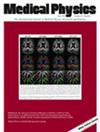The impact of tube voltage on the erosion of rotating x-ray anodes
Abstract
Background
The permitted input power density of rotating anode x-ray sources is limited by the performance of available target materials. The commonly used simplified formulas for the focal spot surface temperature ignore the tube voltage despite its variation in clinical practice. Improved modeling of electron transport and target erosion, as proposed in this work, improves the prediction of x-ray output degradation by target erosion, the absolute x-ray dose output and the quality of diagnostic imaging and orthovolt cancer therapy for a wide range of technique factors.
Purpose
Improved modeling of electronic power absorption to include volume effects and surface erosion, to improve the understanding of x-ray output degradation, enhance the reliability of x-ray tubes, and safely widen their fields of use.
Methods
We combine Monte Carlo electron transport simulations, coupled thermoelasticity finite element modelling, erosion-induced surface granularity, and the temperature dependence of thermophysical and thermomechanical target properties. A semi-empirical thermomechanical criterion is proposed to predict the target erosion. We simulate the absorbed electronic power of an eroded tungsten-rhenium target, mimicked by a flat target topped with a monolayer of spheres, and compare with a pristine target.
Results
The absorbed electronic power and with it the conversion efficiency varies with tube voltage and the state of erosion. With reference to 80 kV (100%), the absorption of a severely eroded relative to a pristine target is 105% (30 kV), 99% (100 kV), 97% (120 kV), 96% (150 kV), 93% (200 kV), 87% (250 kV), and 79% (300 kV). We show that, although the simplistic Müller–Oosterkamp model of surface heating underestimates the benefit of higher tube voltages relative to operation at 80 kV, the error is limited to below −6% for 30 kV (reduction advised) and +13% for 300 kV (input power increase permitted).
Conclusions
Correcting the x-ray conversion efficiency of eroded target material, that is typically not accessible by measuring the tube current, may imply corrections to existing x-ray dose calculations. The relative increase of the allowable anode input power of rotating anode x-ray tubes with increasing tube voltage is substantially smaller than predicted by volume heating models that only rely on the focal spot surface temperature. The widely used voltage agnostic Müller–Oosterkamp formalism fails to predict the tube voltage dependency of the surface temperature of rotating anode targets, ignores the temperature dependency of the thermal diffusivity of tungsten-rhenium, and the granularity of the material. Nevertheless, we show theoretically why, backed by experience, the practical use of the Müller–Oosterkamp formalism is justified in medical imaging and provides a basis for comparison with new microparticle based targets. The reason for this surprising finding is that voltage dependent material erosion must be primarily considered as a precursor of thermal runaway effects.


 求助内容:
求助内容: 应助结果提醒方式:
应助结果提醒方式:


